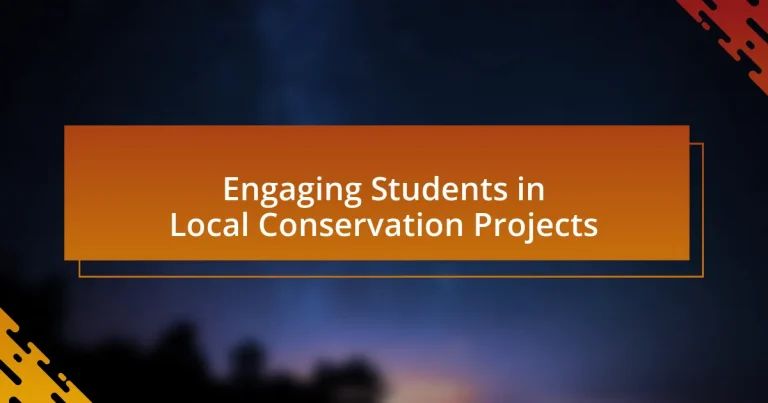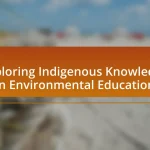Local conservation projects are community-driven initiatives focused on protecting and restoring natural environments. These projects engage local stakeholders, including students, in hands-on activities such as habitat restoration, wildlife monitoring, and community clean-ups, fostering environmental stewardship and enhancing biodiversity. The article explores the importance of these projects for community engagement, the benefits of student involvement, and the challenges faced in participation. It also discusses strategies for educators to integrate conservation efforts into curricula and highlights the role of local organizations in facilitating student engagement in conservation initiatives.
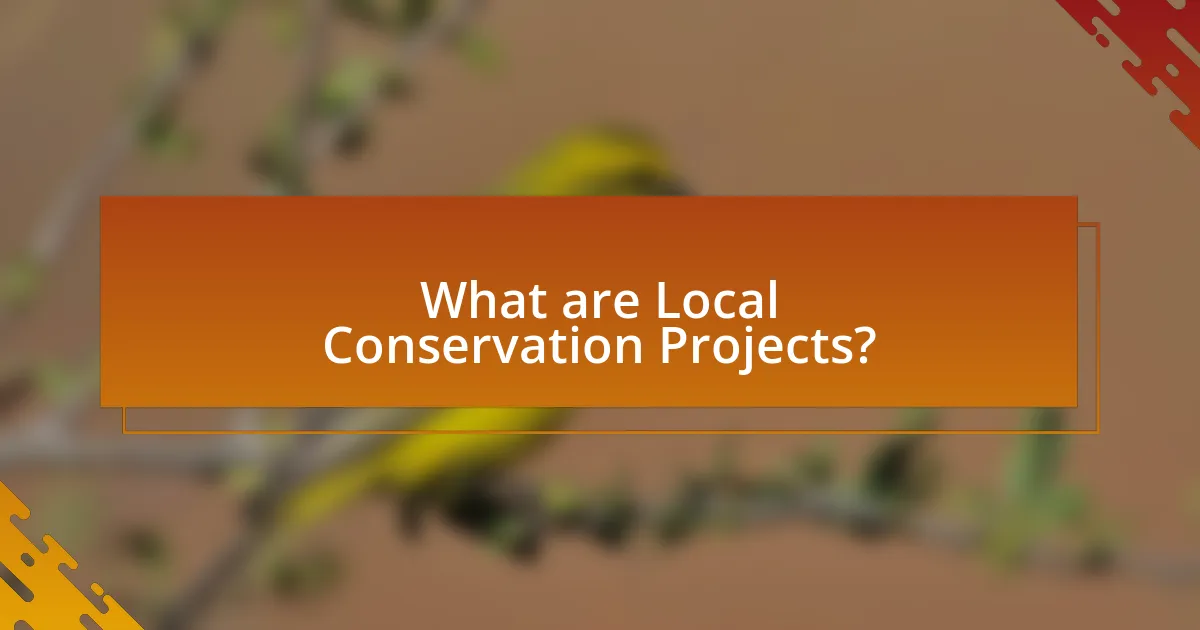
What are Local Conservation Projects?
Local conservation projects are initiatives aimed at protecting and restoring natural environments within specific communities. These projects often involve local stakeholders, including residents, schools, and organizations, working collaboratively to address environmental issues such as habitat loss, pollution, and biodiversity decline. For example, a study by the National Oceanic and Atmospheric Administration (NOAA) highlights that community-led conservation efforts can significantly enhance local ecosystems and foster environmental stewardship among participants.
Why are Local Conservation Projects important for communities?
Local conservation projects are important for communities because they foster environmental stewardship and enhance local biodiversity. These projects engage community members in protecting natural resources, which leads to improved ecological health and resilience. For instance, a study by the National Oceanic and Atmospheric Administration found that community-led conservation efforts can increase local wildlife populations by up to 30% over five years. Additionally, local conservation initiatives often provide educational opportunities, empowering residents, particularly students, to understand and address environmental challenges. This engagement not only builds a sense of community but also promotes sustainable practices that benefit both the environment and the local economy.
How do Local Conservation Projects contribute to environmental sustainability?
Local conservation projects contribute to environmental sustainability by promoting biodiversity, restoring ecosystems, and fostering community engagement. These projects often involve activities such as habitat restoration, species protection, and sustainable resource management, which directly enhance the health of local ecosystems. For instance, a study by the World Resources Institute found that community-led conservation initiatives can increase species populations by up to 50% in targeted areas. Additionally, local conservation projects educate participants about environmental stewardship, leading to long-term sustainable practices within communities. This combination of ecological restoration and community involvement creates a resilient environment that supports both nature and human well-being.
What role do Local Conservation Projects play in community engagement?
Local Conservation Projects play a crucial role in community engagement by fostering collaboration among residents, enhancing environmental awareness, and promoting stewardship of local resources. These projects often involve community members in hands-on activities such as tree planting, habitat restoration, and wildlife monitoring, which not only build a sense of ownership but also strengthen social ties. Research indicates that communities involved in conservation efforts report increased civic participation and improved community cohesion, demonstrating the effectiveness of these initiatives in mobilizing local populations towards common environmental goals.
What types of Local Conservation Projects can students engage in?
Students can engage in various types of local conservation projects, including habitat restoration, community clean-up initiatives, and wildlife monitoring programs. Habitat restoration projects often involve planting native species, removing invasive plants, and rehabilitating ecosystems to support biodiversity. Community clean-up initiatives focus on removing litter from parks, rivers, and other public spaces, promoting environmental stewardship and community pride. Wildlife monitoring programs enable students to track local species, collect data on their populations, and contribute to conservation efforts. These projects not only enhance environmental awareness but also provide hands-on experience in conservation practices.
What are some examples of hands-on conservation activities?
Hands-on conservation activities include tree planting, habitat restoration, wildlife monitoring, and beach cleanups. Tree planting helps combat deforestation and improve air quality, with studies showing that one mature tree can absorb approximately 48 pounds of carbon dioxide annually. Habitat restoration involves repairing ecosystems, such as wetlands or forests, which can enhance biodiversity and ecosystem services. Wildlife monitoring, often conducted through citizen science projects, allows participants to track species populations and health, contributing valuable data to conservation efforts. Beach cleanups directly reduce pollution and protect marine life, with organizations reporting that volunteers can remove thousands of pounds of trash in a single event.
How do different types of projects address various environmental issues?
Different types of projects address various environmental issues by implementing targeted strategies that focus on specific problems such as pollution, habitat destruction, and climate change. For instance, community clean-up initiatives directly tackle pollution by mobilizing volunteers to remove litter from local parks and waterways, thereby improving ecosystem health and biodiversity. Conservation projects, such as tree planting and habitat restoration, combat habitat destruction by restoring native flora and fauna, which enhances local ecosystems and mitigates the effects of urbanization. Educational programs in schools raise awareness about climate change and promote sustainable practices, equipping students with knowledge and skills to address environmental challenges. These approaches are supported by research indicating that hands-on involvement in conservation efforts significantly increases environmental stewardship among participants, as shown in studies conducted by the National Environmental Education Foundation.
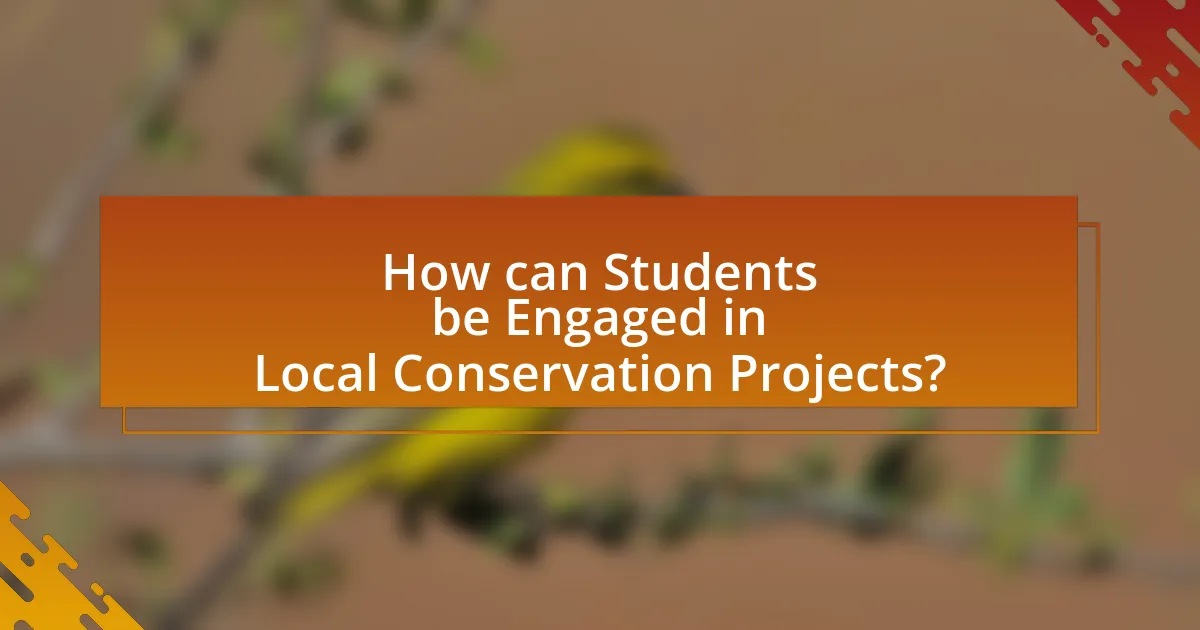
How can Students be Engaged in Local Conservation Projects?
Students can be engaged in local conservation projects by participating in hands-on activities such as tree planting, habitat restoration, and wildlife monitoring. These activities provide practical experience and foster a sense of responsibility towards the environment. Research shows that experiential learning, such as that found in conservation projects, significantly enhances students’ understanding of ecological principles and their commitment to sustainability. For instance, a study published in the Journal of Environmental Education found that students involved in outdoor conservation activities demonstrated increased environmental awareness and pro-environmental behaviors.
What strategies can educators use to involve students in conservation efforts?
Educators can involve students in conservation efforts by implementing hands-on projects that promote environmental stewardship. These projects can include activities such as organizing local clean-up events, creating school gardens, or participating in wildlife monitoring programs. Research shows that experiential learning significantly enhances student engagement and retention of environmental concepts, as evidenced by a study published in the Journal of Environmental Education, which found that students involved in hands-on conservation projects demonstrated a 30% increase in environmental knowledge compared to traditional learning methods. Additionally, collaboration with local conservation organizations can provide students with real-world experiences and mentorship opportunities, further solidifying their commitment to conservation.
How can project-based learning enhance student engagement in conservation?
Project-based learning enhances student engagement in conservation by providing hands-on, real-world experiences that connect students to environmental issues. This approach fosters active participation, as students collaborate on projects that address local conservation challenges, such as habitat restoration or species protection. Research indicates that students involved in project-based learning demonstrate increased motivation and a deeper understanding of ecological concepts, as they see the direct impact of their efforts on their community. For instance, a study published in the Journal of Environmental Education found that students participating in conservation projects showed a 30% increase in their environmental knowledge and a 40% increase in their willingness to engage in conservation activities outside of school.
What partnerships can schools form to support conservation initiatives?
Schools can form partnerships with local environmental organizations, government agencies, and businesses to support conservation initiatives. Collaborating with environmental organizations, such as the Sierra Club or local conservation groups, allows schools to access resources, expertise, and volunteer opportunities for students. Partnering with government agencies, like the U.S. Fish and Wildlife Service, can provide educational programs and funding for conservation projects. Additionally, businesses can contribute through sponsorships, donations, or employee volunteer programs, enhancing the practical experience for students while promoting corporate social responsibility. These partnerships not only enrich the educational experience but also foster community involvement in conservation efforts.
What are the benefits of student involvement in Local Conservation Projects?
Student involvement in local conservation projects enhances environmental awareness and fosters a sense of responsibility towards nature. Engaging in these projects allows students to gain hands-on experience in ecological practices, which can lead to increased knowledge about biodiversity, ecosystems, and sustainability. Research indicates that students who participate in conservation efforts develop stronger problem-solving skills and a greater appreciation for their local environment. For instance, a study published in the Journal of Environmental Education found that students involved in community-based conservation initiatives showed a 30% increase in environmental literacy compared to their peers who did not participate. This involvement not only benefits the students but also contributes positively to the local community and ecosystem health.
How does participation in conservation projects impact student learning outcomes?
Participation in conservation projects significantly enhances student learning outcomes by fostering practical skills, critical thinking, and environmental awareness. Engaging in hands-on activities allows students to apply theoretical knowledge in real-world contexts, which has been shown to improve retention and understanding of complex concepts. For instance, a study published in the Journal of Environmental Education Research found that students involved in conservation initiatives demonstrated a 30% increase in knowledge retention compared to those who learned through traditional methods. Additionally, participation in these projects cultivates teamwork and problem-solving abilities, as students collaborate to address environmental challenges, further enriching their educational experience.
What skills do students develop through engagement in conservation efforts?
Students develop critical thinking, teamwork, and problem-solving skills through engagement in conservation efforts. These skills are cultivated as students analyze environmental issues, collaborate with peers on projects, and devise solutions to real-world problems. For instance, a study by the National Oceanic and Atmospheric Administration found that students involved in hands-on conservation projects demonstrated improved analytical skills and increased environmental awareness, highlighting the effectiveness of experiential learning in fostering essential competencies.
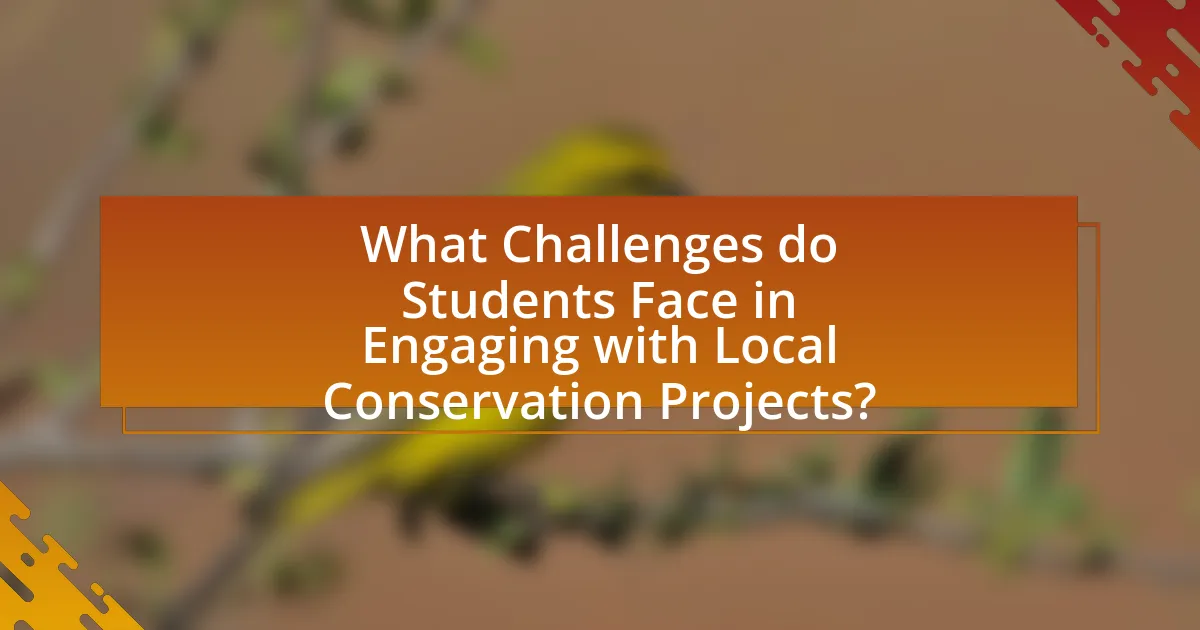
What Challenges do Students Face in Engaging with Local Conservation Projects?
Students face several challenges in engaging with local conservation projects, including lack of awareness, limited resources, and time constraints. Many students are unaware of local conservation initiatives or the importance of their involvement, which hinders participation. Additionally, financial limitations can restrict access to necessary materials or transportation for project involvement. Time constraints due to academic commitments further complicate students’ ability to engage meaningfully in these projects. Research indicates that these barriers significantly reduce student participation in conservation efforts, highlighting the need for targeted outreach and support to enhance engagement.
What barriers might prevent student participation in conservation initiatives?
Barriers that might prevent student participation in conservation initiatives include lack of awareness, time constraints, and limited access to resources. Many students may not be aware of local conservation efforts or their importance, which diminishes motivation to engage. Additionally, academic pressures and extracurricular commitments can limit the time students have available to participate in such initiatives. Furthermore, students may face logistical challenges, such as insufficient transportation options or lack of funding for materials, which can hinder their ability to get involved. Studies indicate that these factors collectively contribute to lower participation rates among students in conservation projects.
How can schools overcome logistical challenges in organizing projects?
Schools can overcome logistical challenges in organizing projects by implementing effective planning and communication strategies. Establishing a clear timeline and assigning specific roles to staff and students ensures accountability and organization. Utilizing technology, such as project management software, can streamline coordination and facilitate real-time updates. Additionally, forming partnerships with local organizations can provide resources and support, enhancing project feasibility. Research indicates that schools that engage in collaborative planning and utilize community resources experience a 30% increase in project success rates, demonstrating the effectiveness of these strategies.
What strategies can be implemented to motivate reluctant students?
To motivate reluctant students, educators can implement strategies such as incorporating hands-on activities, providing real-world relevance, and fostering a supportive classroom environment. Hands-on activities, like participating in local conservation projects, engage students by allowing them to apply their learning in practical settings, which has been shown to enhance interest and retention. Providing real-world relevance connects academic content to students’ lives, making learning more meaningful; for instance, discussing local environmental issues can spark students’ curiosity and concern. Additionally, fostering a supportive classroom environment, where students feel safe to express their thoughts and take risks, encourages participation and engagement. Research indicates that students are more motivated when they perceive their learning as relevant and when they feel supported by their peers and teachers.
How can community support enhance student engagement in conservation projects?
Community support enhances student engagement in conservation projects by providing resources, mentorship, and real-world connections that motivate students to participate actively. When local organizations and community members collaborate with educational institutions, they create opportunities for hands-on experiences, such as fieldwork and workshops, which deepen students’ understanding of conservation issues. For instance, a study by the National Oceanic and Atmospheric Administration found that students involved in community-based conservation projects showed a 30% increase in their commitment to environmental stewardship compared to those who did not have community involvement. This direct engagement fosters a sense of responsibility and belonging, making students more likely to contribute to conservation efforts.
What role do local organizations play in facilitating student involvement?
Local organizations play a crucial role in facilitating student involvement by providing resources, opportunities, and structured programs that encourage participation in community initiatives. These organizations often create partnerships with schools, offering workshops, volunteer opportunities, and mentorship that align with students’ interests in conservation. For instance, studies have shown that students who engage in local conservation projects through organizations report increased environmental awareness and a sense of community responsibility. By fostering connections between students and local conservation efforts, these organizations enhance educational experiences and promote active citizenship among youth.
How can community events promote awareness and participation in conservation?
Community events can promote awareness and participation in conservation by providing interactive platforms for education and engagement. These events often include workshops, clean-up drives, and informational booths that directly involve participants in conservation activities, fostering a sense of community responsibility. For instance, a study by the National Oceanic and Atmospheric Administration found that community-based conservation events increased local participation by 40%, demonstrating the effectiveness of hands-on involvement in raising awareness. Additionally, these gatherings facilitate networking among community members, conservation organizations, and local governments, creating a collaborative environment that enhances conservation efforts.
What are some best practices for successfully engaging students in Local Conservation Projects?
To successfully engage students in Local Conservation Projects, it is essential to incorporate hands-on activities that foster a sense of ownership and responsibility. Research indicates that experiential learning significantly enhances student engagement; for instance, a study published in the Journal of Environmental Education found that students participating in field-based conservation activities showed a 40% increase in environmental stewardship attitudes. Additionally, collaboration with local organizations can provide students with real-world context and resources, making the projects more relevant and impactful. Engaging students in discussions about local environmental issues and allowing them to propose solutions can further enhance their commitment and interest in conservation efforts.
How can educators create a curriculum that integrates conservation efforts?
Educators can create a curriculum that integrates conservation efforts by incorporating hands-on projects that focus on local environmental issues. This approach allows students to engage directly with their community’s ecological challenges, fostering a sense of responsibility and stewardship. For instance, educators can design lessons around local biodiversity, water conservation, or waste management, encouraging students to participate in field studies, clean-up events, or habitat restoration projects. Research shows that experiential learning significantly enhances student engagement and retention of information, as evidenced by a study published in the Journal of Environmental Education, which found that students involved in active conservation projects demonstrated a 30% increase in environmental knowledge compared to traditional learning methods.
What resources are available to support student-led conservation initiatives?
Student-led conservation initiatives can access various resources, including grants, educational programs, and partnerships with environmental organizations. For instance, organizations like the National Wildlife Federation and the Sierra Club offer grants specifically aimed at youth-led projects, providing financial support for initiatives that promote conservation efforts. Additionally, educational programs such as the Eco-Schools program provide resources and frameworks for students to engage in sustainability projects within their schools and communities. Partnerships with local environmental organizations can also offer mentorship, expertise, and logistical support, enhancing the effectiveness of student-led initiatives.
